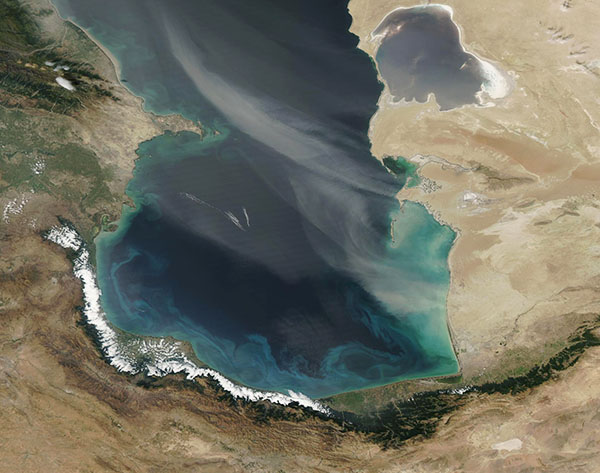Images
September 6, 2024 - Colorful Caspian Sea
Tweet
On September 2, 2024, the Moderate Resolution Imaging Spectroradiometer (MODIS) on NASA’s Aqua satellite acquired this colorful true-color image of the Caspian Sea.
Gray and tan-tinted bands sweep across the Sea from northwest to southeast, widening to create a haze over the water. In broader images, the dust appears to rise from dune fields west of the Volga river in Russia.
At the same time, jewel tones swirl in the deep blue waters of the Caspian Sea, especially along the shorelines. These colors are typical of phytoplankton blooms, but floating sediment—possibly from dust—may also contribute to the color. Phytoplankton are microscopic plant-like organisms that live in these waters in relatively small numbers year-round. Given adequate sunlight, water temperature, and nutrients, phytoplankton can reproduce explosively to create colorful floating colonies, known as “blooms”, that are easily seen from space.
Image Facts
Satellite:
Aqua
Date Acquired: 9/2/2024
Resolutions:
1km (91.1 KB), 500m (300.8 KB), 250m (915.6 KB)
Bands Used: 1,4,3
Image Credit:
MODIS Land Rapid Response Team, NASA GSFC
Tweet
On September 2, 2024, the Moderate Resolution Imaging Spectroradiometer (MODIS) on NASA’s Aqua satellite acquired this colorful true-color image of the Caspian Sea.
Gray and tan-tinted bands sweep across the Sea from northwest to southeast, widening to create a haze over the water. In broader images, the dust appears to rise from dune fields west of the Volga river in Russia.
At the same time, jewel tones swirl in the deep blue waters of the Caspian Sea, especially along the shorelines. These colors are typical of phytoplankton blooms, but floating sediment—possibly from dust—may also contribute to the color. Phytoplankton are microscopic plant-like organisms that live in these waters in relatively small numbers year-round. Given adequate sunlight, water temperature, and nutrients, phytoplankton can reproduce explosively to create colorful floating colonies, known as “blooms”, that are easily seen from space.
Image Facts
Satellite:
Aqua
Date Acquired: 9/2/2024
Resolutions:
1km (91.1 KB), 500m (300.8 KB), 250m (915.6 KB)
Bands Used: 1,4,3
Image Credit:
MODIS Land Rapid Response Team, NASA GSFC




